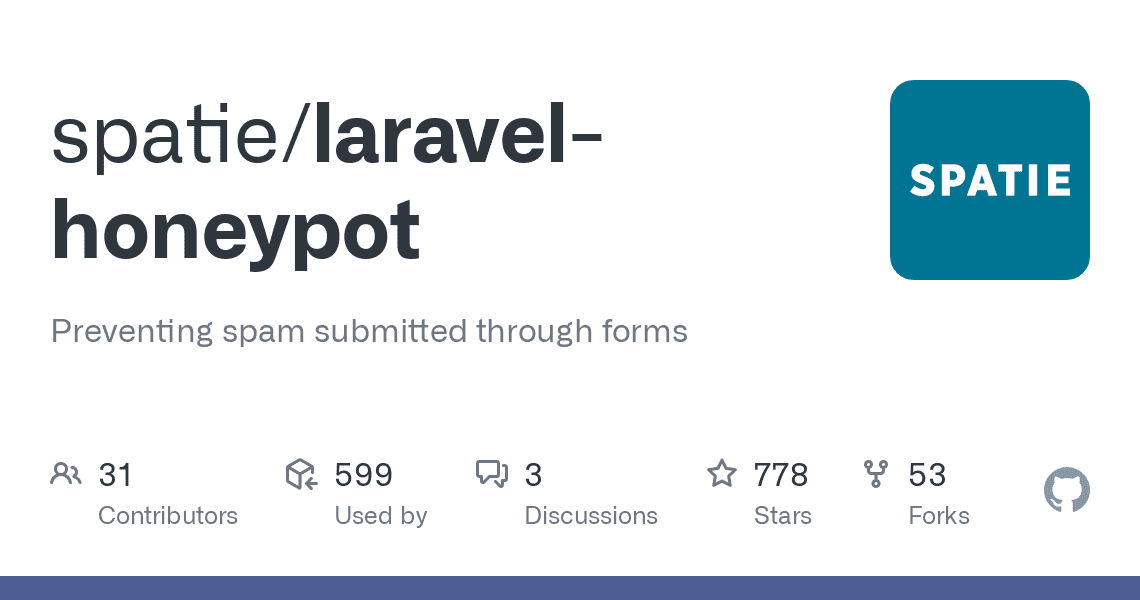
When adding a form to a public site, there’s a risk that spambots will try to submit it with fake values. Luckily, the majority of these bots are pretty dumb. You can thwart most of them by adding an invisible field to your form that should never contain a value when submitted. Such a field is called a honeypot. These spambots will just fill all fields, including the honeypot.
When a submission comes in with a filled honeypot field, this package will discard that request. On top of that this package also checks how long it took to submit the form. This is done using a timestamp in another invisible field. If the form was submitted in a ridiculously short time, the anti-spam will also be triggered.
After installing this package, all you need to do is to add the x-honeypot Blade component to your form.
<form method="POST">
<x-honeypot />
<input name="myField" type="text">
</form>
The package also supports manually passing the necessary values to your view layer to easily add honeypot fields to your Inertia powered app.
Installation
You can install the package via composer:
composer require spatie/laravel-honeypot
Optionally, you can publish the config file of the package.
php artisan vendor:publish --provider="Spatie\Honeypot\HoneypotServiceProvider" --tag=config
This is the content of the config file that will be published at config/honeypot.php:
use Spatie\Honeypot\SpamResponder\BlankPageResponder;
return [
/*
* Here you can specify name of the honeypot field. Any requests that submit a non-empty
* value for this name will be discarded. Make sure this name does not
* collide with a form field that is actually used.
*/
'name_field_name' => env('HONEYPOT_NAME', 'my_name'),
/*
* When this is activated there will be a random string added
* to the name_field_name. This improves the
* protection against bots.
*/
'randomize_name_field_name' => env('HONEYPOT_RANDOMIZE', true),
/*
* This field contains the name of a form field that will be used to verify
* if the form wasn't submitted too quickly. Make sure this name does not
* collide with a form field that is actually used.
*/
'valid_from_field_name' => env('HONEYPOT_VALID_FROM', 'valid_from'),
/*
* If the form is submitted faster than this amount of seconds
* the form submission will be considered invalid.
*/
'amount_of_seconds' => env('HONEYPOT_SECONDS', 1),
/*
* This class is responsible for sending a response to requests that
* are detected as being spammy. By default a blank page is shown.
*
* A valid responder is any class that implements
* `Spatie\Honeypot\SpamResponder\SpamResponder`
*/
'respond_to_spam_with' => BlankPageResponder::class,
/*
* When activated, requests will be checked if honeypot fields are missing,
* if so the request will be stamped as spam. Be careful! When using the
* global middleware be sure to add honeypot fields to each form.
*/
'honeypot_fields_required_for_all_forms' => false,
/*
* This switch determines if the honeypot protection should be activated.
*/
'enabled' => env('HONEYPOT_ENABLED', true),
];
Usage
First, you must add the x-honeypot Blade component to any form you wish to protect.
<form method="POST" action="{{ route('contactForm.submit') }}")>
<x-honeypot />
<input name="myField" type="text">
</form>
Alternatively, you can use the @honeypot Blade directive:
<form method="POST" action="{{ route('contactForm.submit') }}")>
@honeypot
<input name="myField" type="text">
</form>
Using either the Blade component or directive will add two fields: my_name and my_time (you can change the names in the config file).
Next, you must use the Spatie\Honeypot\ProtectAgainstSpam middleware in the route that handles the form submission. This middleware will intercept any request that submits a non empty value for the key named my_name. It will also intercept the request if it is submitted faster than the encrypted timestamp that the package generated in my_time.
use App\Http\Controllers\ContactFormSubmissionController;
use Spatie\Honeypot\ProtectAgainstSpam;
Route::post('contact', [ContactFormSubmissionController::class, 'create'])->middleware(ProtectAgainstSpam::class);
If you want to integrate the Spatie\Honeypot\ProtectAgainstSpam middleware with Laravel’s built in authentication routes, wrap the Auth::routes(); Declaration, with the appropriate middleware group (make sure to add the @honeypot Directly to the authentication forms).
use Spatie\Honeypot\ProtectAgainstSpam;
Route::middleware(ProtectAgainstSpam::class)->group(function() {
Auth::routes();
});
If your app has a lot of forms handled by many different controllers, you could opt to register it as global middleware.
// inside app\Http\Kernel.php
protected $middleware = [
// ...
\Spatie\Honeypot\ProtectAgainstSpam::class,
];
Usage in Inertia
When using Inertia you must manually pass the values used in the honeypot fields. Here’s an example:
// in a controller
public function create(\Spatie\Honeypot\Honeypot $honeypot)
{
return inertia('contactform.show', [
'honeypot' => $honeypot,
]);
}
Your front-end will get an honeypot object with these keys: enabled, nameFieldName, validFromFieldName, encryptedValidFrom.
Here’s an example how these values could be rendered using Vue:
<div v-if="enabled" :name="`${honeypot.nameFieldName}`_wrap" style="display:none;">
<input type="text" v-model="form[honeypot.nameFieldName]" :name="honeypot.nameFieldName" :id="honeypot.nameFieldName" />
<input type="text" v-model="form[honeypot.validFromFieldName]" :name="honeypot.validFromFieldName" />
</div>
And then in your Vue component, add these values to your form data:
props: ['honeypot'],
data() {
return {
form: this.$inertia.form({
[this.honeypot.nameFieldName]: '',
[this.honeypot.validFromFieldName]: this.honeypot.encryptedValidFrom,
}),
}
}
Disabling in testing
By default, any protected form that is submitted in faster than 1 second will be marked as spammy. When running end to end tests, which should run as fast as possible, you probably don’t want this.
To disable all honeypots in code, you can set the enabled config value to false.
config()->set('honeypot.enabled', false)
Customizing the response
When a spammy submission is detected, the package will show a blank page by default. You can customize this behaviour by writing your own SpamResponse and specifying its fully qualified class name in the respond_to_spam_with key of the honeypot config file.
A valid SpamResponse is any class that implements the Spatie\Honeypot\SpamResponder\SpamResponder interface. This is what that interface looks like:
namespace Spatie\Honeypot\SpamResponder;
use Closure;
use Illuminate\Http\Request;
interface SpamResponder
{
public function respond(Request $request, Closure $next);
}
Even though a spam responder’s primary purpose is to respond to spammy requests, you could do other stuff there as well. You could for instance use the properties on $request to determine the source of the spam (maybe all requests come from the same IP) and put some logic to block that source altogether.
If the package wrongly determined that the request is spammy, you can generate the default response by passing the $request to the $next closure, like you would in a middleware.
// in your spam responder
$regularResponse = $next($request)
Customizing the generated honeypot fields
To customize output generated, you can publish the honeypot view with:
php artisan vendor:publish --provider="Spatie\Honeypot\HoneypotServiceProvider" --tag=views
The view will be placed in resources/views/vendor/honeypot/honeypotFormFields.blade.php. This is the default content:
@if($enabled)
<div id="{{ $nameFieldName }}_wrap" style="display:none;">
<input name="{{ $nameFieldName }}" type="text" value="" id="{{ $nameFieldName }}">
<input name="{{ $validFromFieldName }}" type="text" value="{{ $encryptedValidFrom }}">
</div>
@endif
Events fired
Whenever spam is detected, the Spatie\Honeypot|Events\SpamDetectedEvent event is fired. It has the $request as a public property.
Testing
composer test
